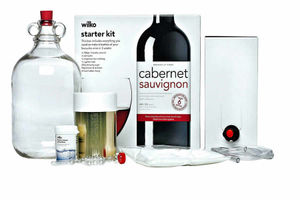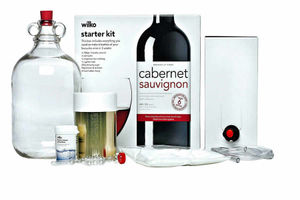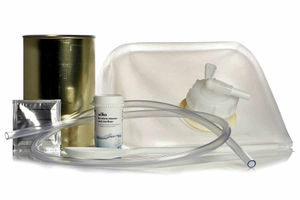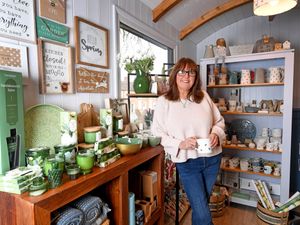What it's like to...Make your own beer and wine
Dry January is looming. After weeks of celebrating the festive season and New Year it's time to abstain from alcohol all in the name of charity. Oh, and perhaps it's a good opportunity to give your liver a chance of recovering.

So whether it's a New Year's resolution, raising money or to get healthy there is one way to keep yourself motivated through a long month of no booze. Brew your own.
In as little as three weeks you can make your own wine or in just four weeks brew your own beer. Sounds like perfect timing.
Completely new to the wine/beer making world, we hopped to it and took on a grape new challenge. But would we be pleasantly surprised or left disappointed by our efforts?
Making wine: How to do it

Before embarking on making wine it was important to read and then re-read the instructions.
Sterilising the demijohn was the first job. The directions were on the label of the cleaning powder so using plenty of water we did as instructed – filling, leaving to soak and rinsing as stated.
Next was emptying the can of wine 'gloop' into the demijohn. Using a funnel was a way to avoid any spills, although it doesn't state this in the instructions. It smelt lovely and fruity and had a very thick consistency.
Once this was in, 450g of brewing sugar was added (using the funnel again to avoid any mess) swirling the demijohn carefully.
Then the sachet of wine yeast and Nutrafine (this is some kind of iron-based powder).
This was the first stage complete. All that was left to do was to put in the rubber bung, half fill the airlock with water and attach it to the bung and then wait. . .
What happened
The demijohn retired to its cardboard box and was left to ferment in the downstairs toilet as this was the smallest and warmest place in the house. (The fermenting process requires a temperature of 20-25C).
On day three it was a case of topping up the demijohn to the 4.5 litre mark with cooled boiled water, again using a funnel.
It says that after a week the fermenting process should be complete. By this point the mixture had a good inch of froth on the top and, above this, what can only be described as a fluffy kind of scum. It looked very unappealing. There were bubbles rising and it was really fizzing up almost as if it was going to erupt and explode.
During this process the water in the airlock seemed to bubble frequently as the carbon dioxide was released from the fermenting wine. This is all normal.
Now, the instructions say 'after fermentation is complete'. . . how do you know? We took to Google and many people advised the use of a hydrometer to read the alcohol level. There was no such device included in the kit (which states it contains everything you need) so we decided to stick to the instructions and not introduce extra bits of equipment. We broke a rule of wine making and guessed (fools!) moving on to the final stage.
We mixed the wine stabiliser in a cup adding cold water to dissolve, then the wine finings swirling as instructed. The wine should clear in 10 days.
Over the course of the next 24 hours it tells you to shake the demijohn gently and frequently to get rid of the unwanted carbon dioxide gas formed during fermentation.
Realistically, sleeping for seven hours then getting up and going to work for the day meant shaking was minimal. The airlock was bubbling quite a bit and the water in it was the colour of the red wine. The froth was still on the top along with scum and bubbles were still rising from the sediment as they did during fermentation. Had it even stopped fermenting?
The demijohn was moved to a cooler area of the house, a cupboard. After 48 hours there was a sudden change. The froth and scum had gone. The airlock was still bubbling slightly and now it was a waiting game to get some lovely clear wine.
Ten days later, the wine wasn't clear.The only way to really be able to see was by shining a torch through the glass: it looked rather murky.
Moving it to the garage meant the temperature was a lot cooler and after 10 more days, the wine was beautifully clear and ready to be bottled.
Once again sterilising the syphon tube, wine bottles, and corks had to be done. Then bottling began which was easy enough.
Curiously there was a bag and box included in the kit but there was no mention of this in the instructions. Perhaps it was an alternative to bottling?
The verdict
We had high hopes for a fruity, fine tasting wine. . . drum roll. . . but were sadly disappointed. An apt description would be initial notes of blackcurrant, not disimilar to Ribena, but then comes the aftertaste, a sharp, bitter, acid hit which left it undrinkable. It's on the rack waiting to age. . .
Some reviewers stated that their wine improved over time, here's hoping. All in all a very simple to follow kit which is great value for money but we should have used a hydrometer to get the fermentation reading correct. Better luck next time!
Making Beer: How to do it

As with the wine we followed the instructions, which were very clear.
It was a case of sterilising the bucket following the directions on the cleaning powder label.
The can of extract – which was thick and resembled treacle – had to be sat in hot water for five minutes before pouring into the
fermenter.
Next up was to add six pints of boiling water to dilute it and topping up with cold water to 20 pints mixing with the spoon provided.
Then we added the sachet of yeast and placed the lid on the fermenting tub with one corner loosely fitted.
The fermenter had to stand in an area where the temperature could be maintained between 18-20C, so off it went to sit by a radiator.
What happened
After four to six days the fermentation process should be complete.
If the mixture is still bubbling then the instructions say to leave it for a further three days or wait until there are no more bubbles rising.
Again we opted to not use a hydrometer (shame on us amateurs, but we wanted to see if it could be done just using what was given
in the kit) and after five days we moved on to the next stage.
The mixture was bubbling slightly and there was a covering of foam and bits of gooey yeast floating on the surface and also
stuck to the bottom. A grimy looking scum was clinging around the top of the tub but apparently this is perfectly normal.
The beer was then syphoned into the dispensing polytainer cube making sure that the tap was securely fitted.
Before doing this, the cube had to be sterilised along with the syphon tube.
It's at this point that the sugar needs to be added. Again in 'the kit which contains all the essentials' the sugar wasn't included. Instead of using 20g of brewing sugar we used granulated sugar as this was an option.
Then it was a case of transferring the beer from bucket to cube but avoiding dislodging the yeast sediment. Tip: don't push the tube to the bottom of the bucket, if you do be aware of any globules passing up the tube and make sure they don't go in the cube.
We made sure that any air in the cube was forced out before screwing on the tap to seal it.
Then it was the waiting game and the cube went off to relax, placed in the bath! We did this as a precaution in case the process went awry and the cube exploded.
Luckily it didn't but did expand to form a ball. When this happened we released the pressure by turning the tap to get rid of the
gas. We had to do this a couple of times.
Two weeks later the foam had gone and the beer was clear-ish and ready to be bottled. It's also OK to drink at this point although it does state that it improves if allowed to mature.
The verdict
While it still looks a little bit cloudy, we sampled a pint and it was certainly palatable. It tasted like a diluted bitter, more of a light beer and was quite watery. But despite lacking much flavour, it is drinkable and goes down easily. At around a pound a pint it's pretty good value.
Top Tips
Make sure you sterilise everything that comes into contact with the liquid thoroughly. If you dont, your wine or beer could become contaminated and ruin your results.
Dont fear the foam! This is part of the process and is perfectly normal.
Buy a hydrometer. its the only way to chart the progress of your fermentation. It measures the specific gravity of fermenting beer or wine. Take a sample of the wine/beer and let the hydrometer float in it while taking a reading from its stem. You can plot the progress and correctly tell when its time to move on to the next stage.
Its extremely difficult to regulate the temperature to 20- 25C which is needed for the fermentation process and also 10C for clearing the wine. Pick a small and constantly warm room for fermenting and move outside to a shed or garage for clearing. (The time of year can also influence these factors).
Give your brew time to mature so a good flavour is achieved




